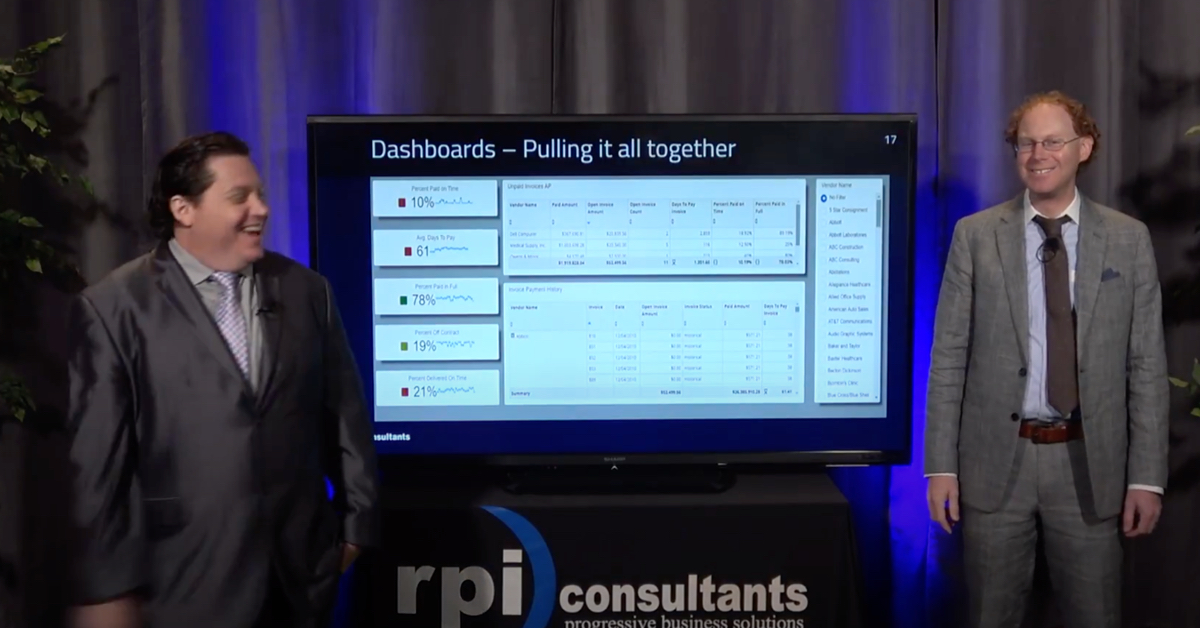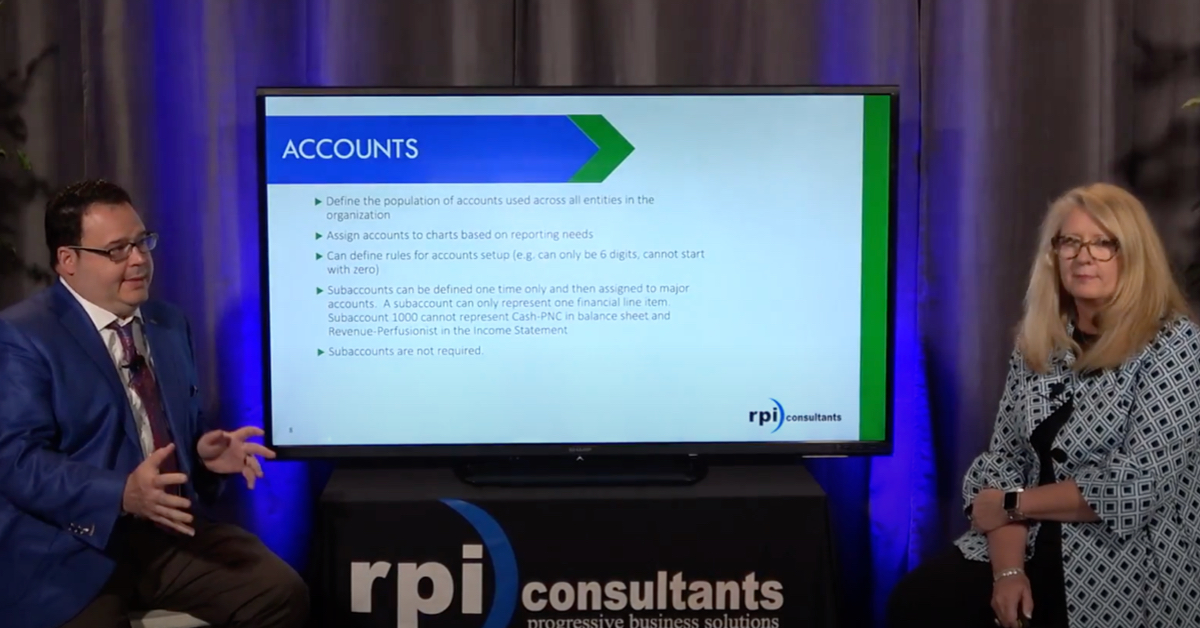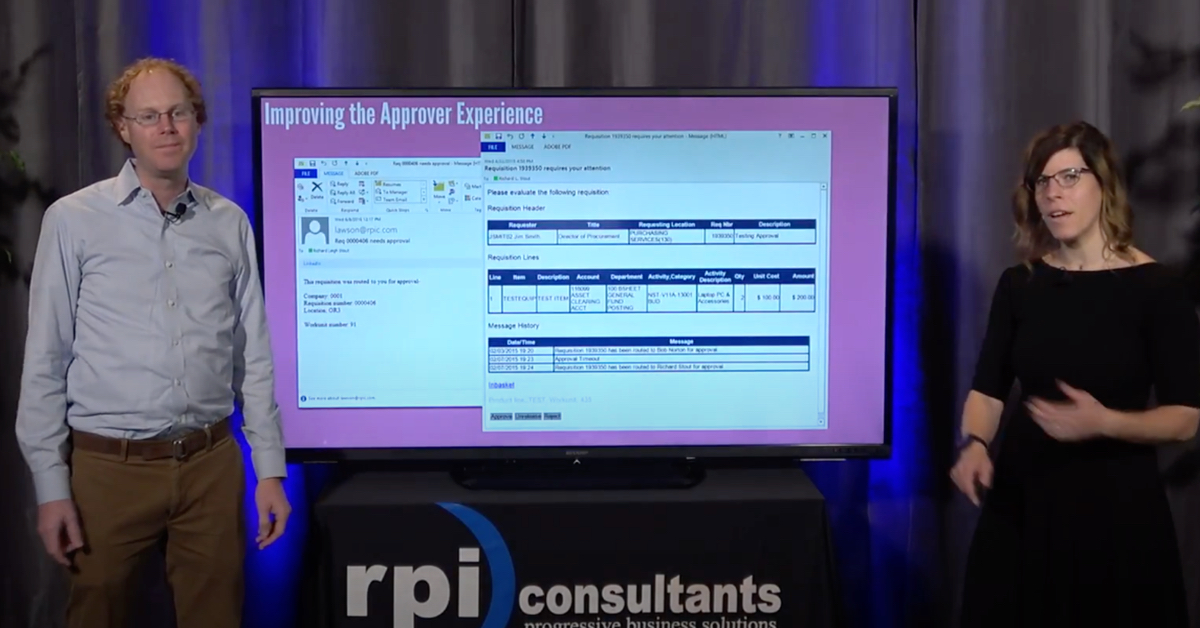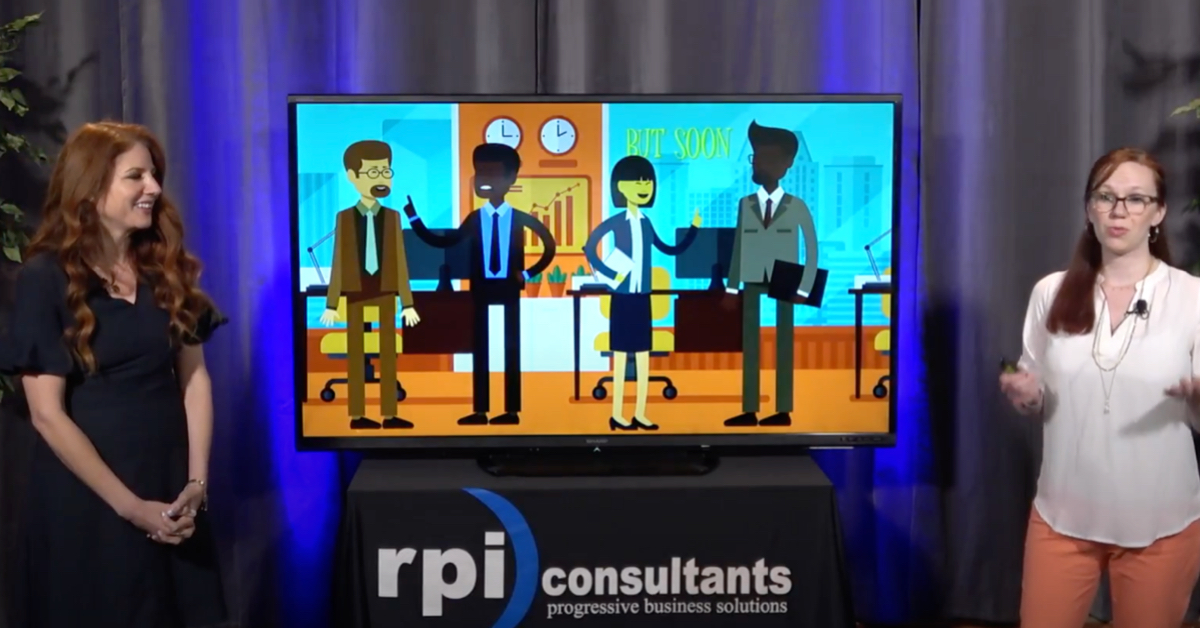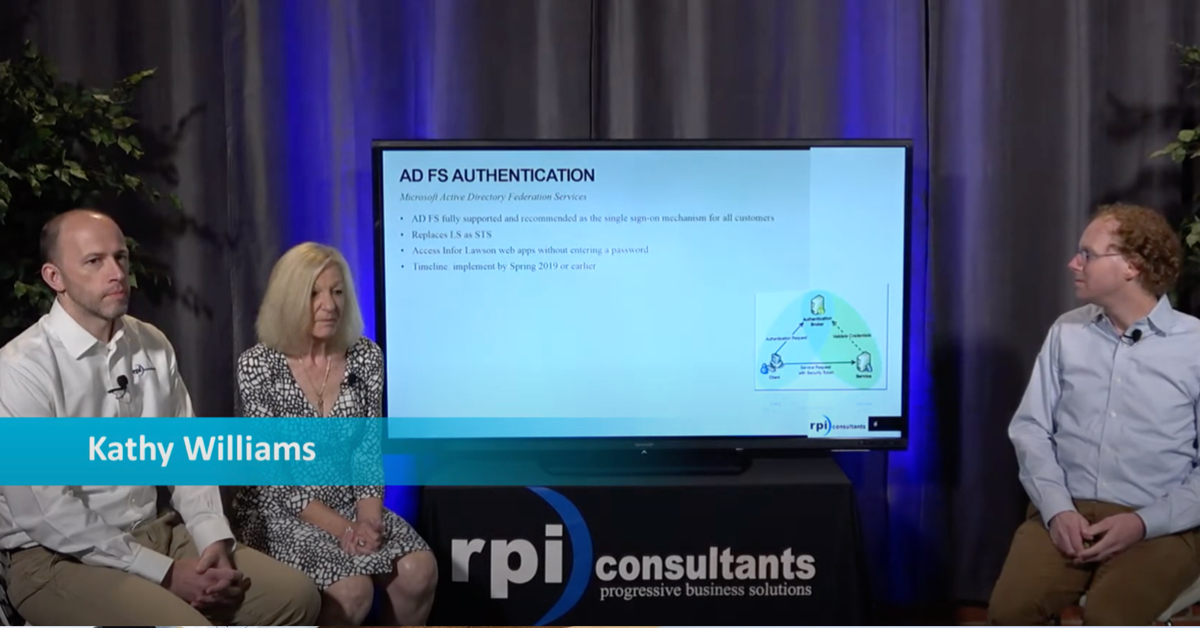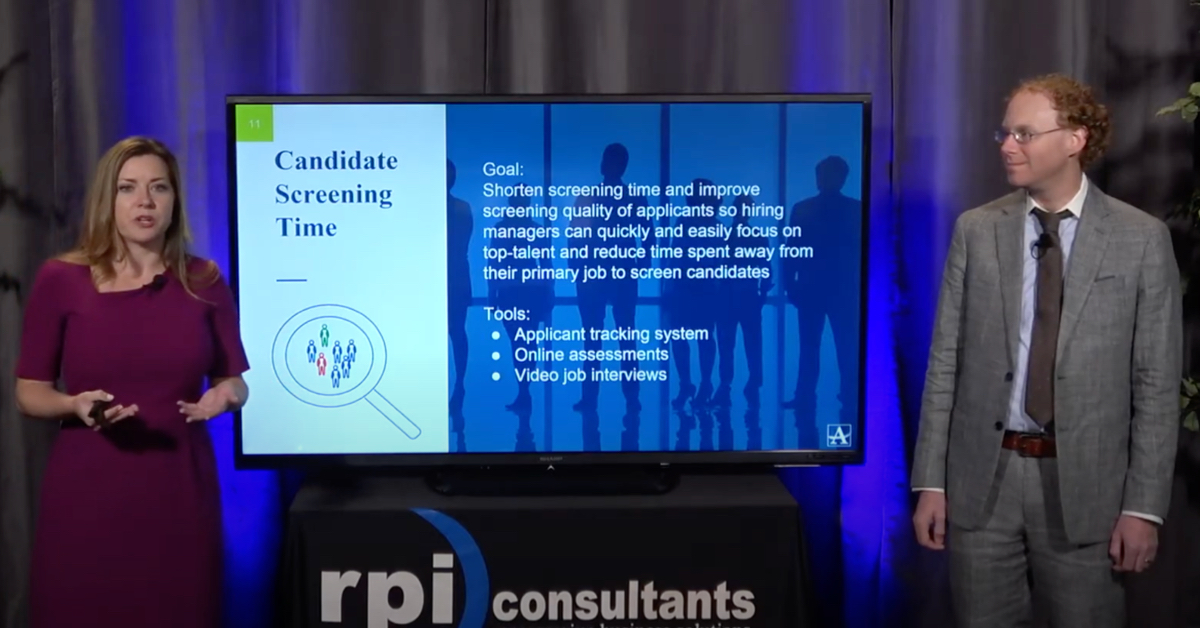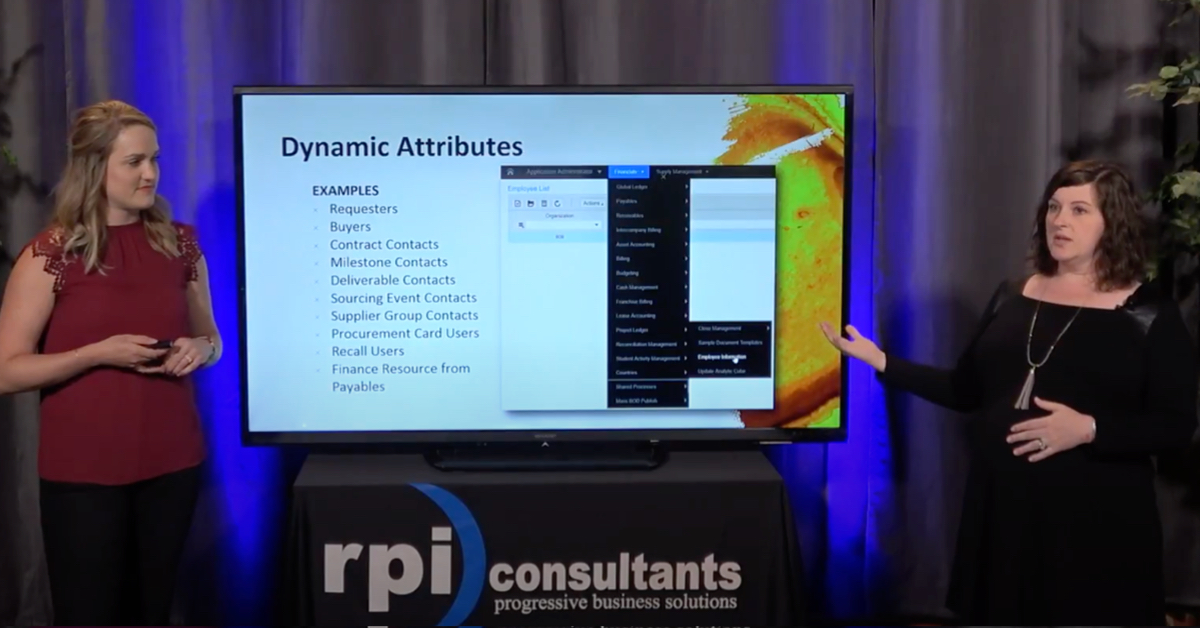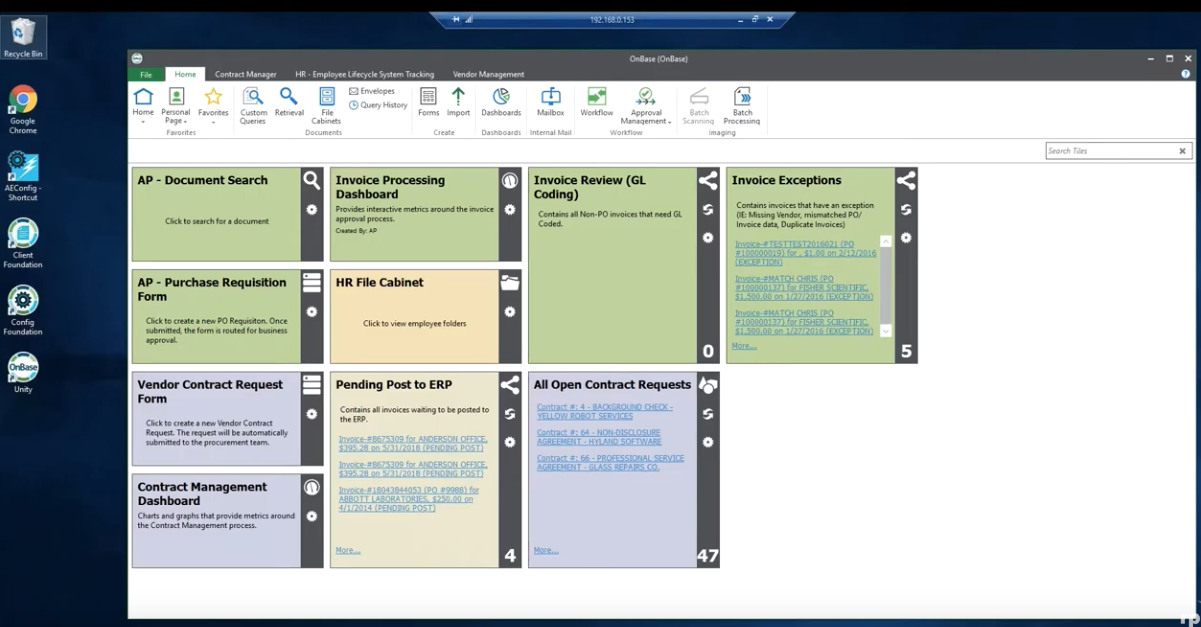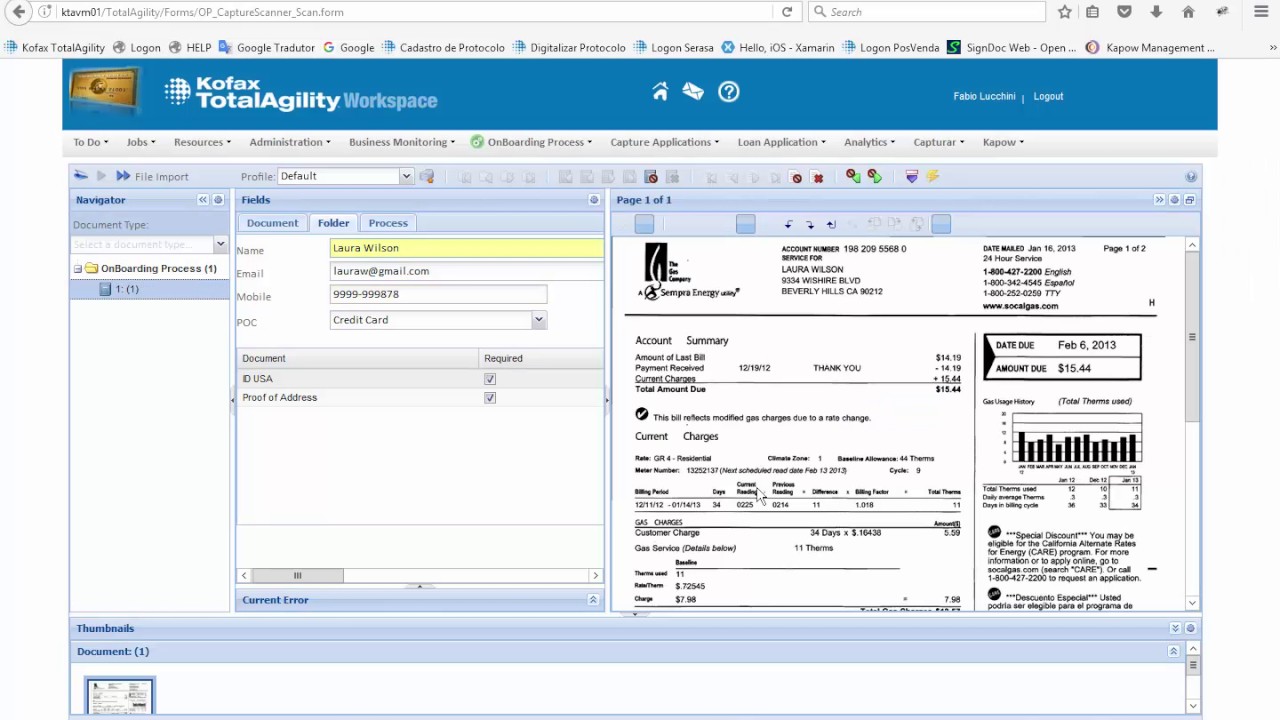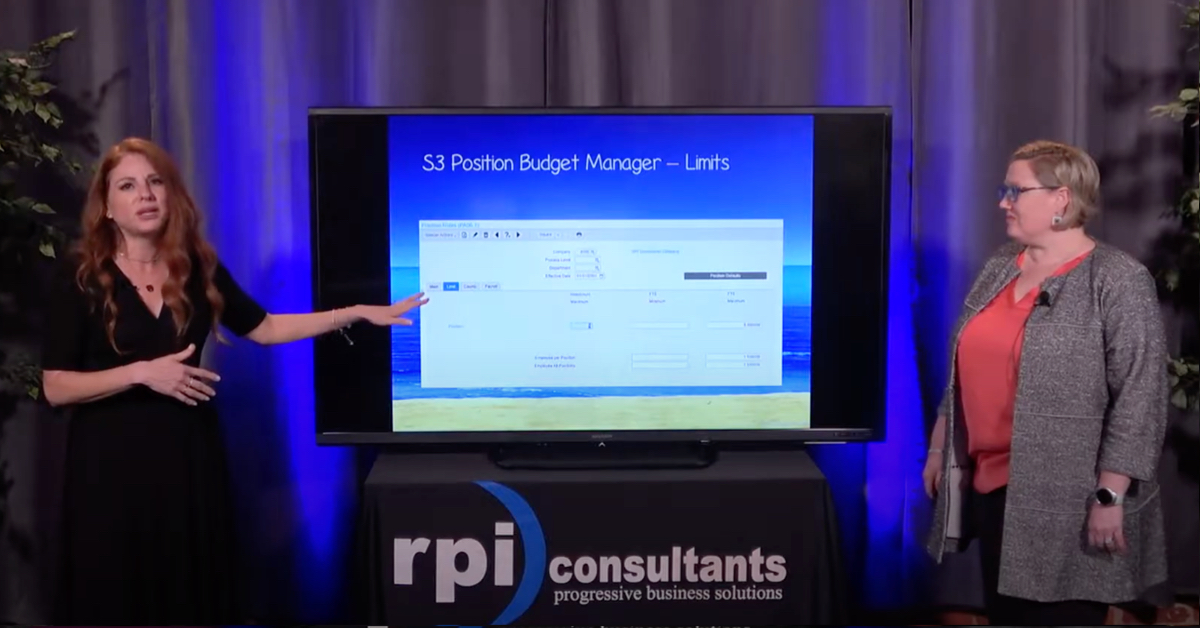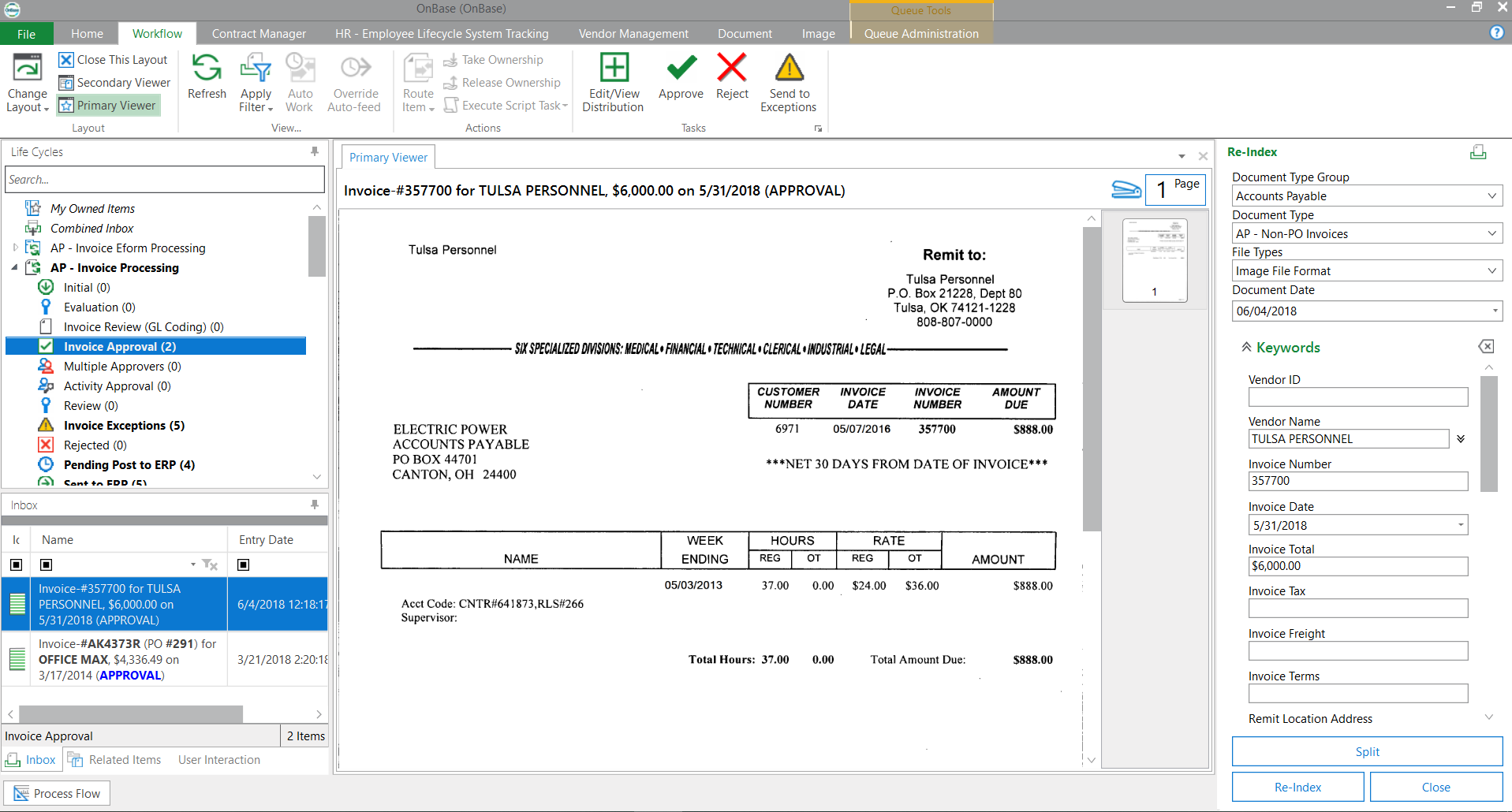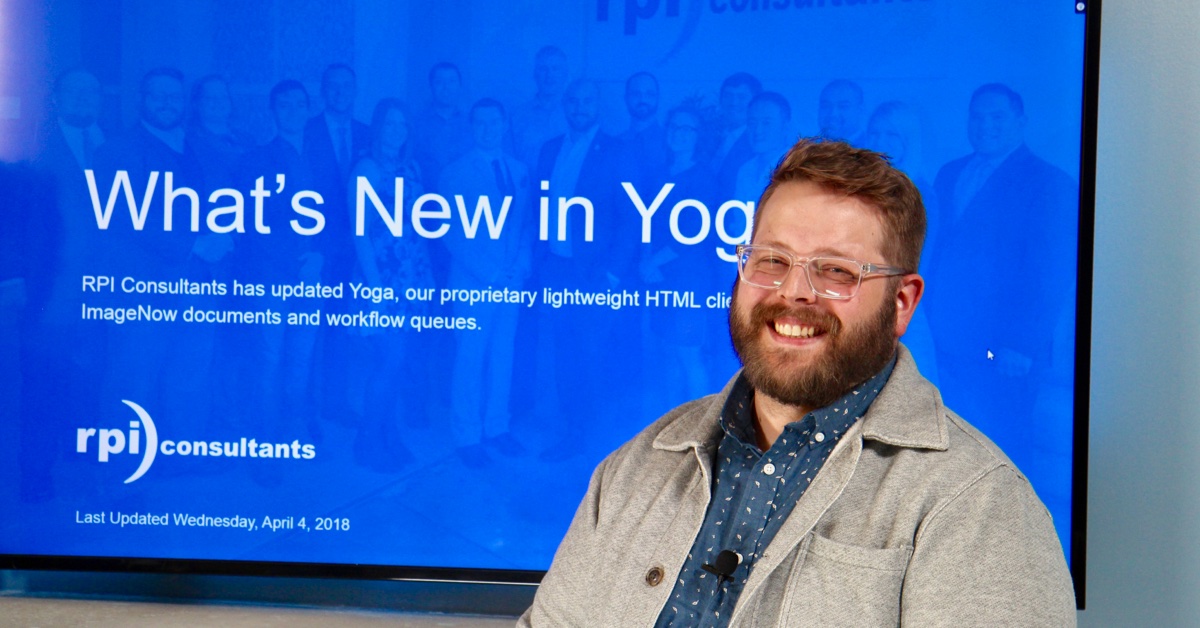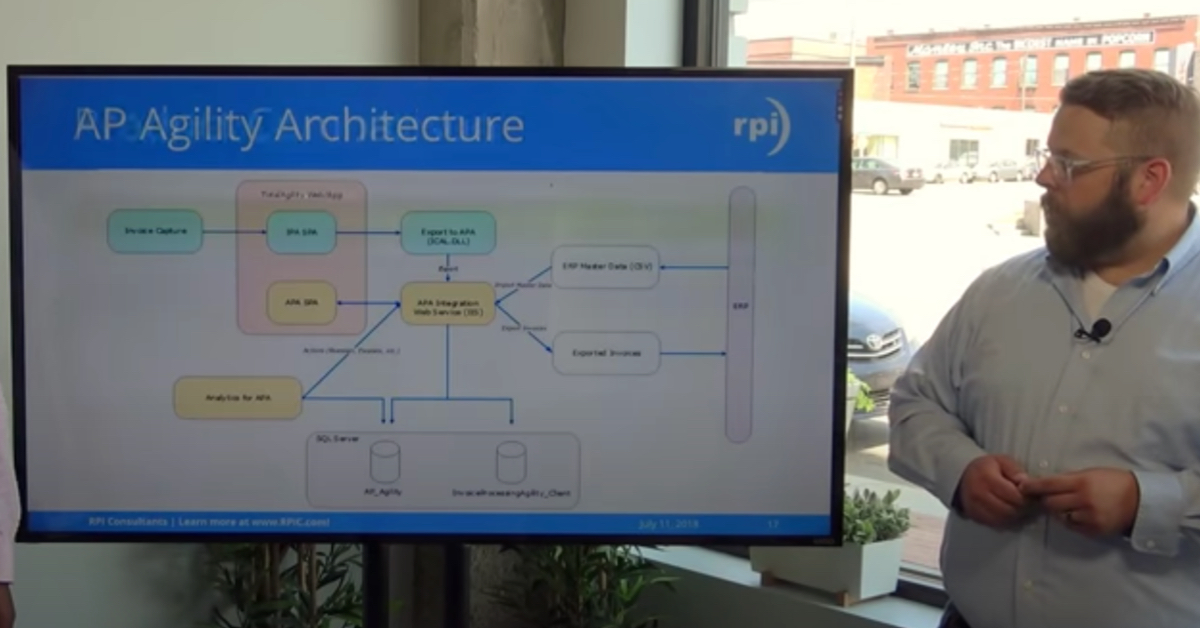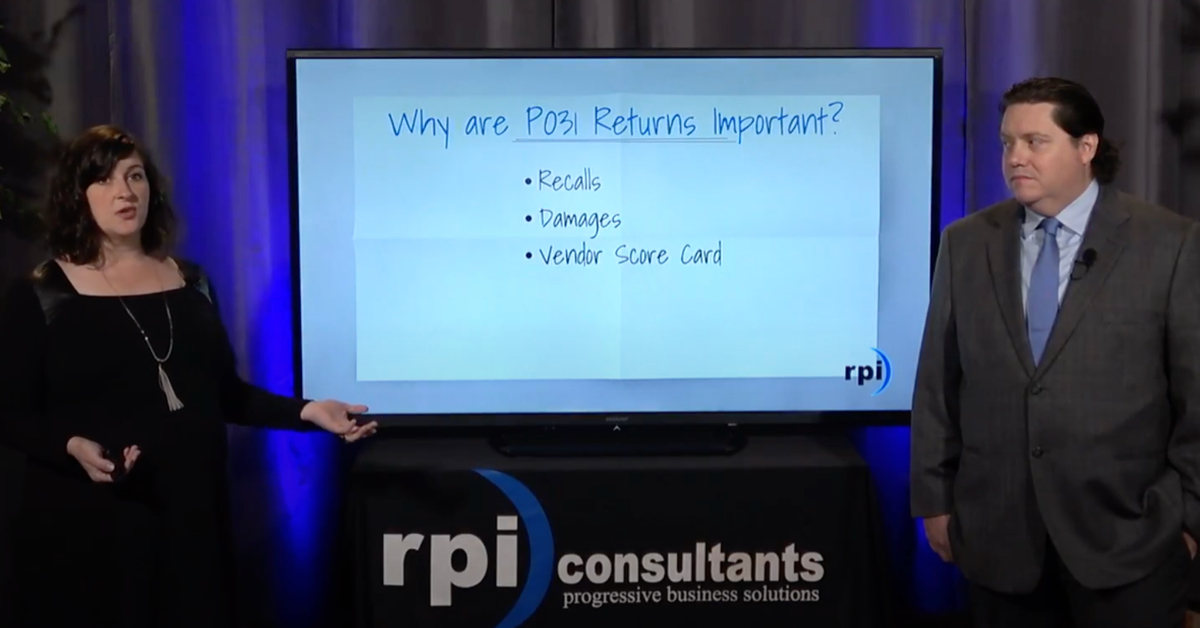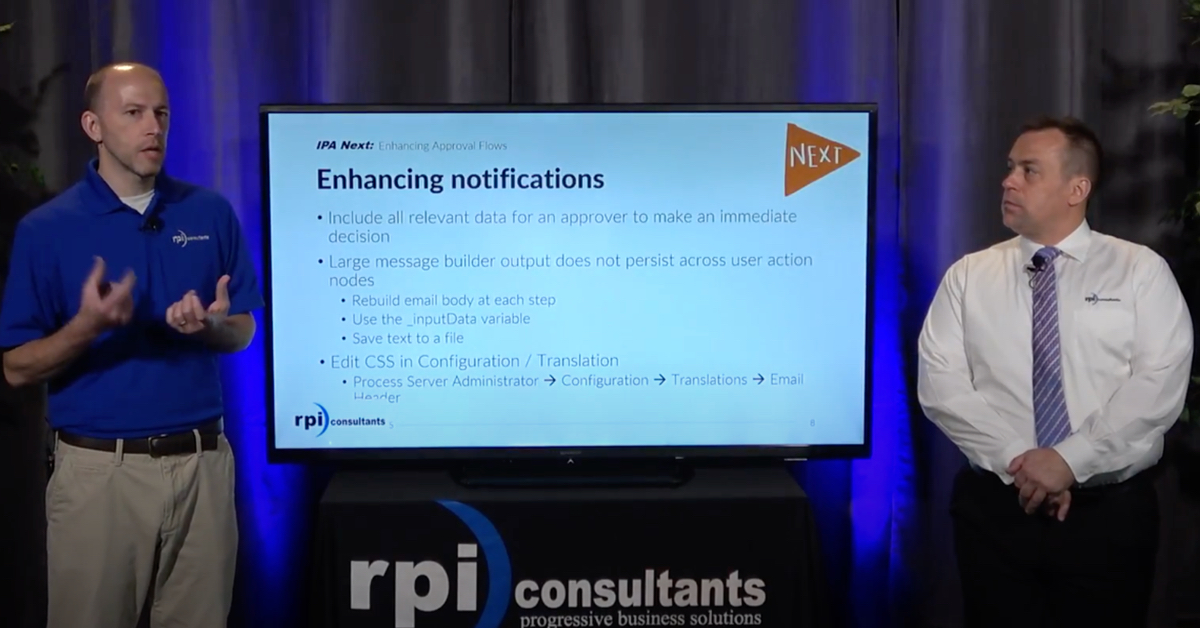What to do with SharePoint in Office 365
Many organizations are migrating to Microsoft’s cloud-based subscription for Office 365 to take advantage of new features, tools, and support. With Office 365, some organizations have access to SharePoint for the very first time. SharePoint has always been known as a document storage solution, but in the last few years the product has received valuable updates and enhancements that include enterprise content management, digital workflow automation, and even webpage building.
In this webinar, RPI Consultants provides a comprehensive overview of SharePoint, including the features you already know about and some you don’t, and discuss ways that SharePoint can be used to consolidate enterprise content management and storage.
Transcript
John Marney:
Thanks for joining us for another RPI Consultants Webinar Wednesday. First Wednesday of every month, presenting content to you on various software platforms that we work with. Make sure my clicker works here. There we go.
Today, we’re going to be talking about what to do with SharePoint and Flows and some other things that are available in Office 365. If you, like me, are fairly new to Office 365, you may have encountered a lot of things that you didn’t previously have access to before, a lot of tools and platforms, and you might be thinking, “Well, how can I leverage these things that we’re paying for, for my organization?” I’m going to help you talk through some of that.
Coming up, we have some additional webinars and office hours. Next month, next Webinar Wednesday, we’re going to have two Kofax centered presentations. Kofax has a new program for migrating from Capture and KTM to Kofax TotalAgility. We’ll talk about that on June 3rd in the morning, and then in the afternoon we’ll talk about upgrading Kofax Process Director to 7.8. That is focused primarily on SAP cloud.
For Office Hours, if you joined us for my morning session today, I did an overview of some digital signature solutions, so next Friday I’m actually going to be doing a deep dive, doing some setups, doing some integrating with DocuSign, AssureSign, Adobe Sign, we’ll see. Please, if that’s something you’re interested in, join me on May 15th.
Then, on May 29th, we’re going to be continuing the office hour that we started last Friday where we did some fairly simple RPA integrations with some Excel manipulations. We’re going to be expanding on that to discuss system and database integration to Kofax RPA as well.
However, the concepts broadly apply to other RPA platforms as well, so even if already have or are already invested in an RPA platform, you may find some valuable content there.
Something new that we’re doing that we’re calling VUE, or Virtual User Exchange, hosted by RPI Consultants on May 21st. The idea is that this is a virtual user group since we aren’t allowed, or shouldn’t, or can’t, whatever, get together for user groups, all day on May 21st, we’re going to be having a number of different tracks. About 75 percent of the content is oriented towards our N4 clients, N4 Lawson. However, My Team, the Content Process Automation team, has a track that has some content for OnBase for accounts payable automation, digital transformation in general, so please, we would love to get some feedback on that. We’re using a cool piece of software that allows us to have a little bit better collaboration. It’s not GoToWebinar, so, really interested to present some content for you there.
A little bit about me, for anybody who has not met me before. My name is John Marney. I’m the practice manager over our team, my team here at RPI Consultants. My team is called Content and Process Automation, so we focus primarily on system integration, on the Kofax and Hyland products, on the Microsoft products that we’re talking about today. I’ve been doing this for around 10 years, and I’ve gotten pretty okay at home haircuts, if I do say so myself.
Okay, so our agenda today, and before I jump into this, please, if you have any questions, feel free to submit those via the GoToWebinar question pane at any time. We’ll take those throughout, especially sometimes it’s easier to answer questions while the context of the slide is available, instead of later.
The recording of this will be sent out afterwards. Of course, recordings of this and any other webinars are available on RPIC.com/webinars.
Today, we’re going to talk a little bit about Office 365, just barely. A little bit about SharePoint itself. Sorry. pop-ups obscuring my…then, we’re going to talk about SharePoint online, which is primarily what the content of this presentation is about and discuss how you might be able to leverage SharePoint in a big way or a small way.
Of course, I have to give myself a little bit of an out. Our disclaimer is that of course this information is accurate to the best of our ability right now, and of the date of this webinar. Of course, since this is SaaS it’s changing constantly and without notice, so this information will become out of date.
Okay, about Office 365. Why is this important? Well, virtually, everybody that I know, every organization that I’ve talked to, is moving from the traditional on-premises or perpetual license of Office 2016, what have you, to Office 365. There’s generally a lot of value in the pricing and it opens up access to a lot more products and service. Obviously, you have your traditional Office apps, such as Outlook, Word, Excel, et cetera, and additionally, add on things that are frequently used. Services like Exchange, One Drive, Teams, SharePoint, et cetera.
There are some license levels where the most basic license levels where things like Teams and SharePoint aren’t available, so this would not apply to you, however, most even remotely medium sized businesses, based on what I can tell, are going to be at the license level that I’m talking about today.
It is a monthly subscription model. It’s SaaS, it is true SaaS, it is Software as a Service, so as long as you pay for it you get access to it. The second you stop paying for it, you don’t get access to it. It is charged per user, most typically, and there are some very small things that are add-ons per user. I’m not really going to touch on that, but that does happen.
You do have automatic updates. So, if you have Office 365 installed on your computer, with Office products, you will see that those will be automatically updated. It’s a benefit that this can enforce some IT versioning, as part of a broader IT strategy.
Well, they gave me an updated image here, and I don’t think I got it, so I apologize, but it tells the same story. We’re talking about really the broader conversation is about the Office 365 ecosystem. You, like me, again, have logged in and seen a whole bunch of apps that you have access to and thought, how can I make use of these things, there are definitely a lot of apps and services, some I had never even heard of, like Yammer. Some that I’ve heard of and never used. Others that I’ve used but, I thought, wow, I actually get this just as part of my subscription.
How can we leverage some of the things that you’re paying for and you have access to? Primarily I’m going to focus on three things and how they tie together. It’s not just SharePoint. It’s SharePoint and Teams, and then tying everything all together and going out and integrating with other systems using Flow. Flow is Microsoft’s workflow tool, also called, well I shouldn’t say also called. There are technically three separate products called Flow, Power, Automate, and Logic apps, however, they all function almost exactly the same way. So, I’m using them interchangeably. Okay, so past present and future of SharePoint. Here is my hilarious, very short version of SharePoint history. In the dark ages of computing, back in 2001, structure on Windows XP, SharePoint was Microsoft’s introduction to try tie Office apps together and really to store files essentially.
It was introduced as Office Server originally but was quickly rebranded as SharePoint. They over the years have layered in additional functionality. One of the first things was active pages, that’s your intranet, right? So, this was borrowed from an older piece of software that Microsoft had called “FrontPage,” if anybody remembers that. They added search and indexing, they added business intelligence forms, additional document storage, all tied in nicely with active directory and security. So, a bunch of stuff happened and today here are arrived in the future and we have SharePoint Online available with Office 365.
Their current SharePoint versions, there’s others too that organizations now may be on, but these are the most relevant, SharePoint 2016 Server and Enterprise flavors, SharePoint 2019 Server and Enterprise flavors and SharePoint Online. So technically SharePoint 2019 is your traditional on premises, and SharePoint Online is the version available in Office 365. In fact, specifically SharePoint Online is what we’re going to be talking about today. A lot of what we talk about today will apply to 2019 and 2016, but I don’t know those, so I’m not going to promise anything. Specifically Plan 2 is what is provided in Office 365 subscription.
So just to reiterate, we are talking about SharePoint Online, just this one. Not the others.
Okay. SharePoint Online. It’s Plan 2 included with many Office 365 subscriptions. Not every level, but from what I could find, Plan 1 is not included in any levels. Plan 1 if you want to subscribe to SharePoint, by itself, is how you can get access to Plan 1.
It offers modern pages. So, if you’re familiar with in the past, it’s had a variety of look and feels for its active pages. For its sites, it has been updated, it has come through various editions with where Microsoft was trying to leverage the Metro UI and we’re all past that now. But it is very much in line with the style of Microsoft today.
It’s fairly easy to set up, easy to use. To me, in my opinion, it has a lot more capability to be adopted at departmental levels or by smaller groups of users without the need humongous amounts of competency building and training that other softwares require. Yet still allowing the IT oversight or governance that you might desire.
A native Teams integration, and by native Team’s integration, what I really mean, that teams in a SharePoint are actually basically at their core the same thing. And I’ll talk about that a little more later.
It is very mobile responsive. Again, with Office 365 being really built from the ground up and on modern technologies and modern platforms, everything is done with the intention or really with the native ability to be very mobile responsive.
And Enterprise Search, you need to find what you need, even within subsites of subsites. It has tremendous amounts of app integration and a lot that leverages the Flow technology that I will talk about.
Okay. Features, Functionality, Integration. Let’s jump into SharePoint.
First and foremost, and I’m using some .gifs inside of the slide, so I would love feedback on that, it’s my first time doing it today, instead of jumping back and forth between videos. So, I’ll narrate them after I run through the slide content. SharePoint sites are your intranet. That is the goal, and that’s really what you should be doing, using them for, in my opinion. Now, not to say that there isn’t a place for other types of sites, non-SharePoint sites on your intranet, but in my opinion, SharePoint should be the front end and the core. The main reason for this is because of how it ties into other applications, other Office applications. And really, that is, at its heart, that is what SharePoint wants to be.
You can create the hierarchy of sites within your organization, so you can start at the top level: Company intranet, down to department intranet, sub-department, individual roles. However, you don’t have to do this, right? If your organization isn’t ready to adopt SharePoint at a company level, you can absolutely just create sites at the department level.
So, these sites can be used to communicate to your users. You can also provide resources to your users. This is where you can publish links to all the how-tos and helps and user guides and everything that you’re doing. It’s departmental news about initiatives about objectives that your department has. It’s everything and anything that you want it to be. It also facilitates user sharing, with some level of collaboration though. Really the deep collaboration will take place in teams.
Inside the .gif, I’m going to let it reset really quick. So, what you see is the typical internet site, or intranet site. I have new post about how our accounts payable department has just finished ReadSoft Online rollout. I liked it so it can show up on somebody’s newsfeed. I can embed images and links. I can leave comments. And then I can actually follow links and have embedded, or external sites take them to wherever I want. Here I have ReadSoft Online, which is our invoice processing portal an SCR platform.
SharePoint is also Enterprise Content Management. This is the other really core feature, this is what SharePoint was originally intended for. You can have one or more document libraries. You can one more document libraries per site. You can have additional security, and all the security is really managed at the user and group level as found in Active Directory. So unlike other content management platforms, where you’re constantly trying to replicate active directories, here it’s baked in, and I think it’s really straight forward in how does that.
It offers Version Controlling, so for contracts, any type of document where storing multiple iterations of that document is important, along with the metadata or forms or content for that version, it allows for that. You can define metadata for a document at the organization or the site level. What I mean by that, is if the organization wants to create a kind of a data dictionary that can control the metadata stored on documents, the data type, the character limits, things like that at the organizational level, you can do that. However, you can also choose to ignore all that and do it at the site level.
Direct office integration, I’m going to explore this a little bit, but it’s really to easy to store things, right? If you open a new Word document from your desktop and go to File, Save, SharePoint is right there and so you would go to save it directly to directories or document libraries that you already have access to.
Again, it’s straight forward security and I think that, it’s any document or content that’s stored in SharePoint is easily accessed from both Teams and One Drive for collaboration or personal cloud, respectively. So, in this .gif, I am opening a document inside of a supplier invoice that’s inside of a directory inside of a SharePoint. I review the document and decide I want to extend it to my cohort Michael Madison. So, I click the share button, it offers me only the people that I’m allowed to share it to, and I click share. And it sends him an e-mail with a link.
So, on top of the intranet and the repository or the content management, you may think the next logical step is “How do I build the workflow or how do I actually build the processes around here?” And within SharePoint you do have access forms so you can attach forms by themselves as documents, you can have forms attached to documents. So, they are available via the Form Library or in a little bit more complex state inside of Power Apps which is the ability to create actual applications.
On top of that, and here is where I think the real power comes in, is that workflow can be facilitated by Microsoft Flow or Power Automate. I referenced logic apps earlier. Logic apps are really just Flows or Power Automate Flows inside of Azure. So those can be migrated or managed either within Office 365 or in Azure. These are very cool. They are both Workflow…it is Microsoft’s Workflow capability as well as their robotic process automation. It makes integrations with other Office systems or without said systems very straight forward. And I’m going to talk a little bit more about that as we go.
It’s nice because most that things that you’re doing for processes and workflows in SharePoint are within a familiar Office interface. I think that this is sometimes undervalued when we’re talking about user adoption, that I don’t think that there’s a single thing that people know better than Office products inside of Enterprise world. So, making that as tightly integrated as possible can, I think, be a huge benefit.
Can facilitate approvals and signatures, it does have some of these things built in, so you can send some things for approval or sign-off without even needing to build any workflow, sort of on a one-off situation. It does maintain document history and the workflow history with document. Of course, you can edit metadata, manipulate it to drive workflow, et cetera.
I got a question. What is SP? SharePoint. Oh. “How to add an index to the SharePoint column?” I’m going to save that more towards the end.
Okay, whoops. So, I want to talk through this .gif. So here I have a document, and I have set up flow to send it out to get approval. So, I actually can select out of the auto main menu to trigger a request for approval from a user. Leave a message, type who the approver is going to be. I just select myself, and then I run the flow. So, this has kicked off the workflow for this W-9, right? So, in this case, I have a new vendor in my accounts payable, I have their W-9 I want to send it somebody for approval. So, you’ll set up that vendor inside of our ERP.
So, the next step is actually is this, and this is actually leveraging a flow that I built in SharePoint to actually send this to the approver. And so in the next side you’ll actually see how it sent me a message in Microsoft Teams, with what’s called a “card,” and it has information in it that’s all built within the flow and I leave a comment, and I say, “Good to go,” and click approve.
And what that does, it is sends the metadata back to the document to say “approve,” which itself can trigger additional workflow, move to a different folder, actually go release a creative vendor inside the ERP, whatever level of automation we want to build. And building that flow took me…I took a template inside SharePoint. I think I built in under an hour, with the card and everything. I actually added some logic and added some details to it. So, it’s really pretty fast to do.
Okay, on the topic of team project and collaboration. So, here’s where we jump to Microsoft Teams. Teams is the collaboration platform on top of SharePoint. In fact, effectively Teams is a SharePoint site to some extent, when you create a new team in Microsoft Teams, it creates a SharePoint site for that team. And if you look at the files inside of Teams, that is pointed directly to the files inside of SharePoint. For all intents a purposes, Microsoft Teams is SharePoint.
That’s not to say that you can’t then create SharePoints that are not Teams, you can. And you can link them later if you so choose. If you’re not familiar with Teams, Teams is awesome, I’m a huge fan of it. It is a chat platform, if you’re familiar with Slack, if you’re familiar with Skype, it is really the evolution of Skype. You can schedule meetings inside of it, it offers full audio/video meetings, screenshare et cetera, file sharing. It allows for collaboration and content creation, so if you want to do a white boarding session, or task management, project management, meeting notes, anything, and create them in Teams and then store them out to SharePoint, it’s very seamless to do so.
It allows for shared documents, flows, permissions, with your SharePoint so typically what you have in one you’ll have in the other. It has .gifs, which are very important to me, near and dear to my heart. And it has tons and tons and tons of integration so if you want to use Trello inside of Teams, great, ready to go. All you got to do is plug it in. You want to use your expense reporting software, Concur or something inside of Teams. Plug it in, ready to go.
There is a huge library of integrations available, apps, and growing all the time. I used an image of a blender here, because to me if my content, right, is the fruit and the ice and the bananas and strawberries and stuff inside of this blender, Teams is the blender and it’s going to blend it all together so that I have a SharePoint smoothie at the end. I’m getting a bad look on that one.
Another feature, or topic, is the personal cloud. I have content in SharePoint, I have content in Teams, but I still have the concept of my personal computer, and my personal devices and how maybe I want to take some things offline. Work on them outside the repositories. And here’s where OneDrive comes in. So, the integration is not always, I don’t want to say not straight forward because it is, it’s not always clear when you first set it up right? When you first log in to Office 365, you might think, “Okay I have Teams, and I have SharePoint, and I have OneDrive, how do they all relate?” It’s really actually, it’s much more straight forward than they present.
OneDrive you can continue as you may not always have, just like Box or Dropbox or Google Drive. You can store your files in there, you can have shared files, that also exists. What you can do is in Teams and in SharePoint, click the Sync button, which my .gif is showing. And what that does is essentially syncs over a folder or a file, or a whole bunch of folders onto your OneDrive so you can access them there as well. What’s great is that OneDrive is now caught up with some of their competitors in that you don’t necessarily require physical storage. So, it doesn’t automatically download a file. I believe the way it works now is that it downloads it the first time you open it, and actually you have personal settings on your OneDrive, to say if I haven’t opened this file in one day, two days, thirty days whatever, remove it from the disk. So, you can still open it and download it again, but it doesn’t actually take disk space, which I think is really valuable because that feature may exist in Box or some competitors, but I have not seen it.
On top of all that custom applications and integration. So, Power Apps have existed for a while. They are a way with a drag and drop builder, build actual custom apps, whether it’s a mobile app or a desktop app, inside of the Microsoft platform. They do have some prebuilt templates for somethings, that you can start with such as time off request, or employee feedback, some other things. The Power Apps do get fairly complicated, so this is really where you’re going to engage more of a development background to leverage these. However, I don’t think they’re really that necessary most of the time. I think that combination of forms and integrations with other apps that you’re already using will solve most problems.
There is again a library of apps and other integration such as Adobe Sign. Adobe Sign has a super native built in tight integration with the Microsoft products, both in Teams and in SharePoint. And so, even on top of that, I think the real message I want to get across is that Flows and Power Automate will help you do whatever you need to do. I have started using these extensively internally with RPI to do all sorts of things. I built one the other day, I wanted to help make it easier for our consultants to build out our internal Wiki for our knowledge repository.
So, I built a flow that anytime they use certain tags within a Teams message, it will automatically write that post out to a staging Wiki page. It then responds to their post with one of those cards that says, “Which Wiki page do you think this applies to?” to help categorize it. And they can choose to respond or not, because maybe it’s a new topic.
And so that took me a couple of hours, and our Wiki inside of Assembler, which is a completely separate system, but that Wiki could also be inside of SharePoint, which we’ll probably end up using honestly. So, the power of these flows, again, as both a Workflow tool to help you further integrate your Office product and as an integration tool for Robotic Process Automation, is really valuable. And I intend to do an Office Hours presentation. Again, our Office Hours are a technical deep dive to actually build out these flows, do integrations, and I take your feedback on what you would like to see, so we can have a collaborative webinar. I intend to do one soon. We’re booked out on our Office Hours through May, so it will probably be in June, so stay tuned for that if that’s something you’re interested in.
Okay, so next topic, and we’ve already kind of talked about this, but this The Cloud. And especially in our current environment, business continuity can’t be undervalued, so this ensures access to your content, your data. Workflows keep running. Nothing is disrupted, regardless of where your users are. And looking forward, where work from home situations may be becoming increasingly common, this is more important than ever.
And also, scalability, which goes right along with, or hand in hand with the business continuity. So, if I all of a sudden have 25 percent of my workforce that works from home increasing to 90 percent of my workforce that works from home, I may need, in a traditional sense, to be shifting resources from place to place. Well since your infrastructure et your platform is managed by Microsoft, there’s no adding processing power, there’s no managing traffic over the network. There’s no adding drive space when you’ve run out. All you have to worry about is getting users access. And that’s kind of accepted as the interoperability. Once they have access, once they’re on 365, I hire an employee, I set them up in their Active Directory groups, they have everything they need.
To me there’s a lot of beauty in adopting the Microsoft Ecosystem for as much as you can because of that alone. I have built all sorts of Active Directory integrations for all sorts of products, and nothing beats getting it from the source. Another excellent benefit is the ability to leverage Azure, so we at RPI develop and deploy some of our Yoga products in Azure to offer Software as a Service. You get access to this, and honestly you have it today if you want it. But it becomes easier, the conversation becomes easier to begin expanding other components within your enterprise into Azure to leverage their ability offer infrastructure or platform as a service.
Okay. What’s next? So how do you begin taking advantage of these things. Whether it’s SharePoint, whether it’s Teams, whether it’s MS Flows, whether it’s any other piece of Office 365. But primarily how do we begin adopting some of this process automation from content management? So, evaluating your current state. So, I think I have some questions for you to ask yourself. And maybe the answer is obvious, maybe it’s not. Maybe these are questions that I can have a conversation with you about to help you answer.
So, do you already own Office 365 or SharePoint or Teams or any other combination of these technologies? Do you have departments with technology gaps? And the answer is almost certainly yes, no matter what organization you are. Do you want to evaluate alternatives to your current collaboration software, to your current content management, or to your current workflow system? And that’s not to say that you should evaluate these items as an alternative. But maybe you already are, or maybe you want to compliment them. I definitely find that using MS Flow as a workflow tool in conjunction with a Hyland Software or Kofax or with Perceptive, is absolutely possible and could actually allow you to extend to the life of the systems as well.
Do desperately want to leverage RPA or other automation, but you don’t know how to start? To me this is the easiest way to start, right? Especially if you are already Office 365 subscriber, you have zero cost to go build some RPA inside an MS Flow. Do you lack IT governance? Now this is a complicated topic, but we find that in RPA and workflow building and everything, after they get too expansive, IT suddenly feels like “whoops, we have users building this here, and departments building this here and we don’t know who has what.” So, if everything is done inside, or more and more is done inside the Office 365 platform, whether it’s SharePoint or what have you, because of the ability to build the structure organization down, IT can actually affect governance from the get-go. And if you don’t, it’s easier to do it later.
Do you find yourself exploring enterprising-grade solutions inside an operational budget? So again, the marginal cost of beginning work inside of an existing Office 365 subscription is extremely low and I find that since it is Microsoft that there’s a lot of free content available, training content. If you park your best, smartest person in front of Flow for 4 hours, they’re going to being able to mock-up something useful.
Do you want to reboot your strategy for digital transformation? Maybe you’ve never had a strategy for digital transformation. Maybe you’re finding that the piecing together systems in your current strategy isn’t as effective as you want it to be. Again, I find these tools, really solid, not just on their own, as SharePoint as content management system. Fine, I also find them very effective as gap fillers and integration pieces.
So, some ways to start small, again we have low barriers to entry, but we can make them even lower. Building just a tiny bit of competency with any of these pieces of software can really start to open your eyes as to what the possibilities are. I think that starting with a little RPA, finding something, whether it’s a quality of life improvement or a task that takes 10 hours that we can automate into one, doesn’t matter. Starting with one RPA file or an integration with existing products and going from there is the best way to do that.
You can leverage SharePoint to build department landing page, I think that’s a great way to start. There’s tons of departments and even entire organizations who don’t really have an effective intranet. Where do your employees go when they have a question? Where’s the Wiki, where’s the repository of links or URLs to their job aids or their resources. I think that’s an excellent way to leverage SharePoint.
And I would say, only consider documents, content, forms, really anything that’s physical or secured or anything like that, only consider those when you’re ready, right? The big chunks. Your content repository can lead this become a bigger project than you want to take on right now, and so because some of these technologies are so great at being just integrations don’t worry about that. Leave your documents in OnBase, leave them in Box, leave them on people’s computers. We’ll worry about that have felt this out and are ready to go.
So, planning large scale change. So, we’re feeling more comfortable with these products, or maybe we have the need, right now for a larger enterprise shift. I would say that number one, if you haven’t adopted Office 365 yet or are in the process of it, or even if you’ve done it recently; settle in with your new Azure Active Directory, settle in with Office Apps and any other infrastructure that you moved up or changed. Active Directory is not a straightforward application, it has different models depending on what you’re adopting, whether your continuing to use it on premises, whether you’ve moved it all the way to Azure Active Directory, whether you have a hybrid approach. It matters for your strategy down the stream for other applications, so I would say, definitely make sure that is ready to go, or at least you are clear on what the vision is.
Like with any change, like with any migration, like with any new adoption, it’s important that we clean up existing products and solutions. So, what do I mean by that? I mean that as systems are used, E-D, like with any system, whether it’s a car, or our office, or my bedroom at home, they naturally move a disordered state, it’s thermodynamic. It’s important we revisit those before we try to affect large change, otherwise we may be carrying bad habits, we may be carrying junk data with us as we move into a new world.
I think that documenting existing flows and architectures is important, not because we want to replicate those exactly, but we always have to understand the current state before we can discuss future state, before we can analyze and understand what needs to change.
Evaluating whether a migration is necessary, if that’s something you want to take on, whether you can continue to use, your current applications or even legacy applications, or if existing applications can be embedded. So, you may want to use SharePoint as an intranet, but you don’t want to use it a content repository. Well, you absolutely could do that by embedding your existing content repository within SharePoint.
Okay, so all of this said, how do you pick a consultant partner? Well, I’m going to make my best pitch for RPI. I think a partner should understand digital transformation. So, what I mean by that, is in my mind, digital transformation is replacing tasks, it’s not replacing people. People are the most important asset to your organization, and because they are the most important asset to your organization, we want to make sure that they are doing the most valuable activities for them and for the organization. They should know the business concepts; they should know why you’re doing business and what your goals are. So, my team, is automation team, but we’re complimented by multiple functional practices at RPI.
We have financial consultants, we have human resources consultants, we have supply chain consultants, we have technical consultants, we have all sorts of skills and skill sets that we can bring in for any given project. I also think it’s interesting that in this case we’re practicing what we preach. We use Azure for again, for our Yoga products, for our sand boxing. We use Office 365, I’m uncovering new, awesome things everyday. We use Teams extensively, we use SharePoint, I use MS Flows, I’m going to be continuing to push for filling the gaps in my process with these technologies.
Okay so, we’re going to take any questions. I had written up here, while I consider that. So again, just a quick summary. We talked a little bit about Office 365, high level, a little bit about SharePoint, high level. Delved into the primary use cases for SharePoint, Teams and Flows or Power Automate, discussed the apps available and integrations and then discussed a little bit about how you could road-map SharePoint for your organization.
We had one question about how to add an index to a SharePoint column. I think I can open up the question.
So my quick understanding, and again, I’m not necessarily not a SharePoint technical expert, so I may want to get back to you on this, so I may want to get back to you on this to clarify, but, there’s two ways that SharePoint columns can really be…at least in SharePoint online can be created. At the organizational level where you’re sort of defining that data dictionary that I discussed and at the site level. At the organizational level is where you would be able to create an index to a SharePoint column, in terms of making it searchable. And I believe you can also add, then security around that, so that certain people can only search for certain things and get certain results et cetera.
Okay, I’m not seeing any other questions immediately. If you have any, please feel free to reach out. Again, if you have any, please submit them via the side pain here. Do you have any ideas for things you would like to see inside of the Office Hours Technical Review, feel free to submit those as well.
So again, RPI is hosting our first Virtual User Exchange on May 21st, this is basically Virtual User Group, webcams highly encouraged, and we’ll have some additional content, a little bit more about SharePoint, we’ll have a session some digital transformation and whatnot. Process automation et cetera, again, I highly encourage our import clients on this webinar on signing up as there’s, I don’t know, 50 different sessions planned on different topics.
Upcoming webinars again next month is a couple Kofax topics, we have Office Hours coming up on Digital Signature Solutions and Kofax RPA.
And I got another couple questions in that I think I’m going to reach out individually to try and answer. So, if you submitted one, I will do that.
That’s it for today, if you don’t know who RPI is, we’re 100+ full-time consultants, full staffed professional services. We are partners with Infor as our ERP provider, and Kofax and Hyland. We’re based in Baltimore, but we have offices in Tampa and Kansas City. We run the gamut on technical and professional services across a lot of different products and solutions.
If you are in need of help, please feel free to reach out [email protected], you can hit me up at [email protected]. A lot of different ways to get ahold of us. Thank you for joining me today, please feel to go to rpic.com/webinars to sign-up for additional webinars and content. Thank you.
Want More Content?
Sign up and get access to all our new Knowledge Base content, including new and upcoming Webinars, Virtual User Groups, Product Demos, White Papers, & Case Studies.
Entire Knowledge Base
All Products, Solutions, & Professional Services
Contact Us to Get Started
Don’t Just Take Our Word for it!
See What Our Clients Have to Say


Denver Health
“RPI brought in senior people that our folks related to and were able to work with easily. Their folks have been approachable, they listen to us, and they have been responsive to our questions – and when we see things we want to do a little differently, they have listened and figured out how to make it happen. “
Keith Thompson
Director of ERP Applications


Atlanta Public Schools
“Prior to RPI, we were really struggling with our HR technology. They brought in expertise to provide solutions to business problems, thought leadership for our long term strategic planning, and they help us make sure we are implementing new initiatives in an order that doesn’t create problems in the future. RPI has been a God-send. “
Skye Duckett
Chief Human Resources Officer


Nuvance Health
“We knew our Accounts Payable processes were unsustainable for our planned growth and RPI Consultants offered a blueprint for automating our most time-intensive workflow – invoice processing.”
Miles McIvor
Accounting Systems Manager


San Diego State University
“Our favorite outcome of the solution is the automation, which enables us to provide better service to our customers. Also, our consultant, Michael Madsen, was knowledgeable, easy to work with, patient, dependable and flexible with his schedule.”
Catherine Love
Associate Human Resources Director


Bon Secours Health System
“RPI has more than just knowledge, their consultants are personable leaders who will drive more efficient solutions. They challenged us to think outside the box and to believe that we could design a best-practice solution with minimal ongoing costs.”
Joel Stafford
Director of Accounts Payable


Lippert Components
“We understood we required a robust, customized solution. RPI not only had the product expertise, they listened to our needs to make sure the project was a success.”
Chris Tozier
Director of Information Technology


Bassett Medical Center
“Overall the project went really well, I’m very pleased with the outcome. I don’t think having any other consulting team on the project would have been able to provide us as much knowledge as RPI has been able to. “
Sue Pokorny
Manager of HRIS & Compensation
MD National Capital Park & Planning Commission
“Working with Anne Bwogi [RPI Project Manager] is fun. She keeps us grounded and makes sure we are thoroughly engaged. We have a name for her – the Annetrack. The Annetrack is on schedule so you better get on board.”
Derek Morgan
ERP Business Analyst


Aspirus
“Our relationship with RPI is great, they are like an extension of the Aspirus team. When we have a question, we reach out to them and get answers right away. If we have a big project, we bounce it off them immediately to get their ideas and ask for their expertise.”
Jen Underwood
Director of Supply Chain Informatics and Systems
Our People are the Difference
And Our Culture is Our Greatest Asset
A lot of people say it, we really mean it. We recruit good people. People who are great at what they do and fun to work with. We look for diverse strengths and abilities, a passion for excellent client service, and an entrepreneurial drive to get the job done.
We also practice what we preach and use the industry’s leading software to help manage our projects, engage with our client project teams, and enable our team to stay connected and collaborate. This open, team-based approach gives each customer and project the cumulative value of our entire team’s knowledge and experience.
The RPI Consultants Blog
News, Announcements, Celebrations, & Upcoming Events
News & Announcements
Navigating Infor Lawson On-Premise Changes: Is It Time to Migrate to CloudSuite?
Chris Arey2023-07-20T05:11:10+00:00July 11th, 2023|Blog|
Infor Connect 2023: Top 5 Essential Takeaways
Chris Arey2024-04-04T20:13:35+00:00June 27th, 2023|Blog|
Town of Apex Looks to Enhance Community Services Through Digital Transformation with Infor and RPI Consultants
Chris Arey2024-05-07T17:55:25+00:00June 20th, 2023|Blog, Press Releases|
Infor’s GL Report Designer: Empowering Financial Reporting
Chris Arey2024-02-29T20:52:24+00:00June 13th, 2023|Blog|
CloudSuite ERP: Why Migrating From On-Premise is a Must
Chris Arey2023-08-04T19:14:50+00:00May 30th, 2023|Blog|


